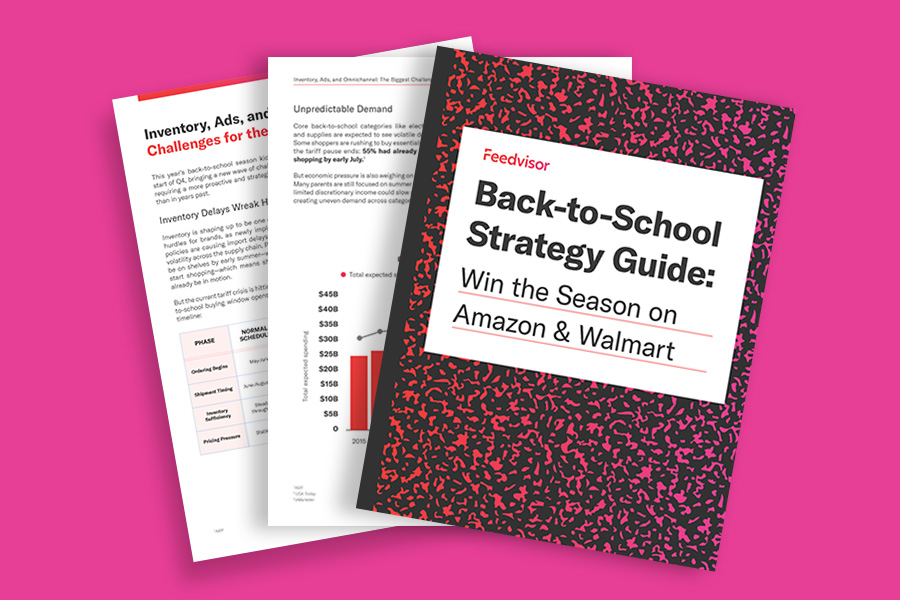
Categories
Latest Posts
Tags
Advertising Amazon Amazon Advertising Amazon Experts Amazon Listing Optimization Amazon Marketplace Amazon News Amazon Prime Amazon Professional Sellers Summit Amazon Seller amazon sellers Amazon Seller Tips Amazon Seller Tools ASIN Brand Management Brands Buy Box Campaign Manager Conference COVID-19 downloadable Dynamic Pricing Ecommerce FBA FBM Holiday Season industry news Multi-Channel Fulfillment Optimize pay-per-click Pricing Algorithm Pricing Software Private Label Profits Repricing Repricing Software Revenue Sales Seller Seller-Fulfilled Prime Seller Performance Metrics SEO SKU Sponsored Products Ads Strategy
Get the latest insights right in your inbox
Resource | Blog

Amazon Unboxed 2024: What’s Next in Advertising Innovation
SUMMARY
The cookie is crumbling. With third-party cookies becoming increasingly unreliable and consumer privacy taking precedence, brands are shifting their focus to first-party data collection. A recent study shows that 65% of brands are realigning their data strategies to emphasize first-party insights rather than third-party sources. As brands move away from relying on third-party cookies, they are turning to their own first-party data for essential audience targeting, measurement, and optimization.
In response, Amazon announced the release of its Ads Data Manager (ADM) at this year’s Unboxed 2024, empowering advertisers to better leverage their first-party data, overlaying these incredibly important signals with data from Amazon’s vast user universe. This all-in-one solution within Amazon Ads allows brands to create a comprehensive first-party data strategy. Yet, navigating the ins and outs of ADM can be daunting and time-consuming for many brands and merchants.
To help, we’ve outlined its key features below. Keep reading to learn how to effectively leverage Amazon’s latest full-funnel advertising tool and maximize the impact of your first-party data.

Rachel Horner
Ads Data Manager: A Quick Breakdown
At a high level, Amazon’s new Ads Data Manager offers a privacy-safe, user-friendly interface that allows advertisers to upload their first-party data once and utilize it across various ad products. It essentially acts as a new user interface, where advertisers and their partners can directly create and manage audiences within Amazon’s ecosystem using first-party data without the need for external audience setup in tools like LiveRamp.
In other words, ADM essentially serves as a bridge, giving access to external data sources directly through Amazon’s interface.
Before the introduction of Amazon Ads Data Manager (ADM), brands had a more fragmented process for managing their first-party data across Amazon’s ad products. Common challenges included:
- Advertisers would often need to upload their data separately to each Amazon ad product. This meant repeated data transfers and setup for each product or campaign, which took time and increased the risk of inconsistencies.
- For audience building and targeting, brands frequently had to rely on external tools, like LiveRamp, to manage data for creating audiences. This required more manual coordination and integration work between Amazon Ads and these third-party platforms.
- Without a unified interface, advertisers had to handle conversion tracking and reporting in silos across different Amazon products. This made it challenging to get a full view of campaign performance across Amazon and non-Amazon sites, as conversions were tracked separately depending on where the data was uploaded.
Amazon Ads Data Manager solves for this, streamlining the handling of first-party data and giving advertisers more direct control over audience building and conversion tracking.
This feature is particularly valuable because it simplifies the process of creating and deploying campaigns with external data, reducing dependency on multiple platforms and allowing more seamless cross-platform audience targeting and conversion tracking. It allows seamless sharing of first-party data across Amazon’s ecosystem, giving advertisers unprecedented control over audience targeting.
What’s more, the ability to create audiences using clients’ first-party data and track conversion activity from non-Amazon sites through the Amazon Ads Data Manager provides brands with a comprehensive solution for audience management and performance reporting. With both first-party data and external conversion data available within ADM, brands can achieve enhanced performance insights and more precise conversion tracking for a holistic first-party data strategy.
ADVERTISING OPTIMIZATION
Leverage the Latest Advertising Innovations to Win on Amazon With the Leading AI technology and Team
How to Make Ads Data Manager Work for Your Brand
Ads Data Manager can make your first-party data work harder than ever before, but how? Below are our top recommendations.
1. Tailor Your Exclusions for Better Results in Amazon Campaigns
To protect sales and avoid cannibalization, it’s crucial brands ensure they do not target customers who are more likely to purchase directly from their websites. With ADM, Amazon has access to the brand’s first-party customer data and can identify which of those customers are likely to purchase from external sites, enabling brands to exclude those customers from their Amazon advertising campaigns.
By creating defined swim lanes—distinct categories that separate customer ownership—brands can clearly distinguish between their customers and the customers Amazon engages. This approach allows brands to own their customer relationships while Amazon manages its own audience, minimizing overlap and competition.
The result: Brands can avoid spending money on ads targeting customers who are already likely to make a purchase without the need for additional advertising. Instead, they can focus on reaching new or less engaged customers who might not already be loyal or familiar with their products.
2. Build Larger Lookalike Audiences To Expand Reach
By scaling successful campaigns with rich first-party data insights, brands can tap into a broader pool of potential customers
Consider that Amazon’s data, while valuable, is primarily focused on user behavior within its ecosystem. It offers insights into how users interact with products on Amazon but may not provide the same depth of understanding about individual customer preferences or behaviors outside of that platform.
What’s more, brands do not own this data, which limits their ability to leverage it across multiple channels in the same way they can with their own first-party data.
First-party data, on the other hand, is owned by a brand, giving them full control over how it’s used. They can segment and analyze this data according to their own marketing strategies and goals, ensuring that lookalike audiences are tailored to their specific needs. However, first-party data comes with its own issue — the audience size is often relatively small compared to that of Amazon’s, according to our DSP specialist.
“First party data is often small compared to Amazon’s own 1P audiences. Using this data on its own limits brands to a small audience pool—ADM allows clients to both build and significantly scale their lookalike audiences.” – Doug Kaplan, Head of Programmatic at Feedvisor
Using ADM, brands can more effectively leverage first-party data to build large, data-rich lookalike audiences, expanding their reach beyond direct website visitors. This strategy enables them to connect with an array of potential customers who may not have engaged with the brand before but are likely to be interested due to their similarities to existing customers.
3. Share and Synchronize Audience Data Across Multiple Platforms
An audience created in ADM can be pushed into Amazon’s platform, but it can also be sent to other platforms like The Trade Desk, enabling brands to distribute and activate the same audiences across multiple advertising platforms.
By doing so, brands can avoid having to recreate the same audience individually on each platform. This ensures that audiences are consistent and optimized across all channels, which can both boost campaign efficiency and streamline audience management.
4. Measure the Impact of Your Campaigns with Full-Funnel Reporting
Last, but certainly not least, is the ability to better measure the impact of your campaigns. First-party data often exists in silos and without the proper context — making it difficult to understand the full picture of your campaign, especially as consumers move across more and more platforms before their final conversion.
ADM allows brands to track and collect data on key customer interactions and conversion events, particularly those that occur outside of Amazon. This can include:
- Clicks
- Purchases
- Sign-Ups
After brands onboard these events into ADM, they can then send this data into Amazon Marketing Cloud for a more granular analysis—essential for full-funnel reporting. By integrating conversion events from ADM and other invaluable data all in AMC, brands can eliminate data silos and understand the customer journey.
With these insights, brands can make informed, holistic decisions that enhance both immediate campaign performance and long-term strategy.

Advertising Optimization
Supercharge Your DSP Campaign Performance With Feedvisor’s Data-First, Full-Service Solution
Final Thoughts
Amazon’s new Ads Data Manager and other advertising capabilities are promising tools, but unlocking their full potential requires brands to invest thoughtfully in their implementation. To fully capitalize on these innovations and optimize campaign performance, advertisers need a dedicated team that stays ahead of industry trends, especially as Amazon continues to push the envelope with its latest features.
That’s where Feedvisor’s AI-driven advertising platform and team of brand experts make a difference. As leaders in Amazon Advertising innovation, Feedvisor drives engagement at every funnel stage, leveraging Amazon’s latest advancements to push your campaigns forward—get started with a free 14-day trial.





